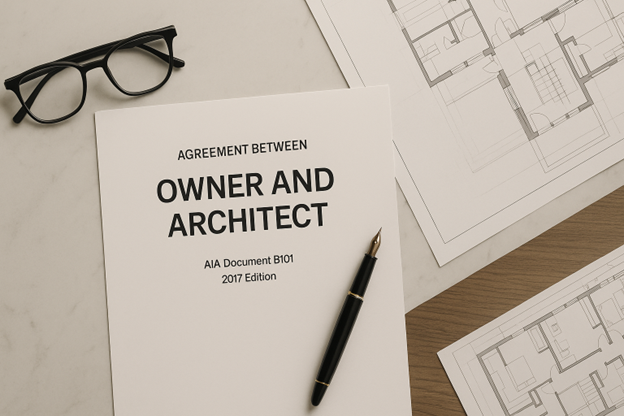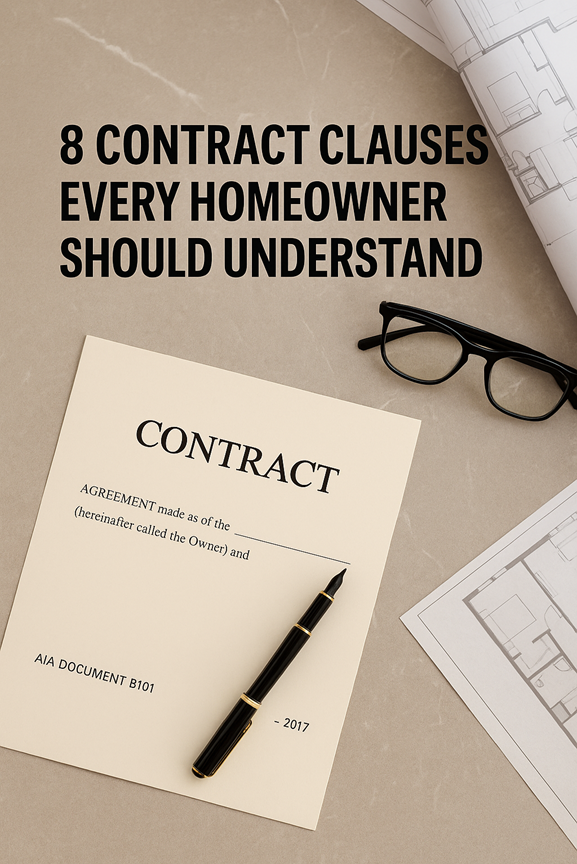Disclosure:
This article is for general informational purposes only and does not constitute legal, architectural, or construction advice. Reading this post does not create an attorney–client or professional relationship. Contract language and regulations may vary by state and project type. Homeowners should consult a licensed architect or qualified construction attorney before signing any agreement or beginning work.
– Achlab
Homeowners, there are many types of construction contracts and several major organizations that develop standardized versions. These include the American Institute of Architects (AIA), Design-Build Institute of America (DBIA), Engineers Joint Contract Documents Committee (EJCDC), ConsensusDocs, Associated General Contractors of America (AGC), and the Construction Management Association of America (CMAA). Each framework serves different parties to their strengths towards Owner, Architect/Engineers, or Contractors. We are going to focus on the commonly known AIA contract B101-2017. Exploring the relationship between the owner and architect.
Key Takeaways
- Clarity prevents conflict.
- Know your protection from design errors, budget creep, and deviations.
- Contracts are living documents
Understanding AIA Contract Families
Before diving into the clauses, it’s helpful to understand that the AIA B101–2017 belongs to a larger, coordinated family of contract documents. Each part of “B-1-0-1” has a purpose:
B = Owner–Architect Agreement (the relationship type)
1 = Prime Agreement (main professional contract)
0 = Delivery Method (conventional Design-Bid-Build)
1 = Sequence Number (distinguishes it from other forms like B102)
2017 = Edition year (AIA releases major updates about every 10 years—2007, 2017, and the next in 2027).
How to Choose the Right Construction Method for Your Custom Home (and a Smart Tool That Can Help)
Learn how your contract structure ties into your construction method
Read Now →Most importantly, B101 is not a standalone contract, it is to be paired with other AIA documents for example you could have along with B101 is A101 Owner Contractor Agreement, C401 Architect Consultant Agreement, B201 Supplemental Services, A701 Bidding, G701-G704 G series for Construction Administration. just so you know, A201 General Conditions is not a contract but a document. They all are related, and play a role in the big binder contract. One big family, I'm sure I'm missing some cousins, but these are the common core.
1. Scope of Services
Let’s begin in the B101! Scope of Service, this section defines what your architect is responsible for. When the project is being developed there is alot of assumption what need to be done. To take out the guess work you want to identify if interior design, site visits during construction, or coordination with engineers to be included. If it is not clear it leaves room for disputes to arise because homeowners assume these services are included when they are not. The clearer the scope, the fewer the surprises.
2. Standard of Care
The B101 mentions the architect will perform “consistent with the professional skill and care ordinarily provided by architects practicing in the same locality.” Basically, it comes down to your architect must meet the ordinary level of skill expected from professionals in similar circumstances—not perfection. Being aware of this prevents unrealistic expectations and misplaced blame. The AIA also has cannons, that part of mindset.
3. Construction Administration
Once the design is complete, the architect’s role often shifts unless the agreement includes Construction Administration service. It should be clear the expectation of your architect regarding site visits, inspections or review progress payments. This is a key layer of protection for homeowners because the construction administration phase helps catch errors early, ensuring your contractor follows the drawings and specifications.
4. Compensation
Money, Money, Mo-neyy! Alright, Architectural fees are often lump-sum or percentage-based on total construction cost, smaller projects could charged hourly. As a homeowner, know what happens next if X happens. Understand how design changes, delays, or budget increases will affect your Architect’s fee structure. Projects can easily ballon into something bigger, known as scope creep. Therefore the contract should have a breakdown on how “Additional Services” are rendered.
5. Owner’s Responsibilities
The B101 is not a one-way street, as the owner you have responsibilities too. The B101 outlines your duties: providing surveys, soil reports, and timely decisions (try not to overthink it). Failing to do so could delay the project and void claims against the architect or contractor later. Think of it as your participation clause. The AIA defines this as timely decisions, providing accurate information, and paying invoices as agreed. Do not fear, put some skin in the game!
6. Termination Clause
Have you ever noticed when signing up for a subscription service it is super easy, name, card info and done. Then when you decide to cancel there are many hurdles and run arounds to get out of it! So, when it comes to the B101 If you want to end the agreement, you can ‘for convenience’ but typically requires a written letter (at least 7 days notice) and payment for services rendered. Always know how to exit cleanly without breaching the contract.
7. Dispute Resolution
Most AIA agreements include a tiered system. Mediation first, then arbitration or litigation. Choosing arbitration can save time and money, but it also limits appeal rights. Review this with a legal professional before signing. Also, select and agree which route is the first step, some projects can opt out mediation going straight into arbitration or litigation. Yikes!
8. Change Orders and Cost Control
Overall, Contracts should define how changes are documented and approved. The B101 has a structure to help the architect verify change orders before the owner signs and approves, maintaining budget transparency. Homeowners keep in mind this falls under the construction administration phase. During the Design portion the architect is supposed to provide a cost estimate after key milestone the schematic, design, and construction phase. While the contractor estimate provides labor, material, and other expenses. Another way to oversee the cost is by working with an agent or advisor but that is a different and simile contract.
Conclusion
There is so much more to cover! Building your dream home is a major investment both emotionally and financially. Understanding these 8 clauses does not make you a lawyer, but it does make you more informed as a client. The AIA B101 is designed to balance risk between architect and owner, but only if you understand it. I highly recommend reviewing your AIA agreements or other contracts with a construction attorney before breaking ground! Trust, your future self will thank you.
About The Author
Join the Achlab Newsletter
Get weekly insights on architecture, design law, and lifestyle — delivered straight to your inbox.
Subscribe NowBook a Consultation
Ready to bring your project to life? Get tailored guidance on home design, permitting, or construction strategy with Achlab.
- Perfect for early-stage scopes & homeowner questions






